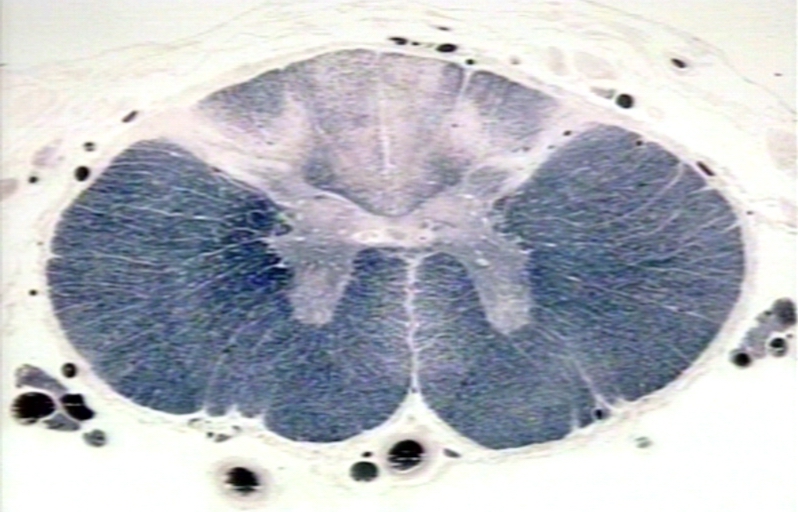Tabes dorsalis
| Tabes dorsalis | |
 | |
|---|---|
| Tabes Dorsalis, degeneration of dorsal columns and dorsal roots at thoracic level Image courtesy of Professor Peter Anderson DVM PhD and published with permission © PEIR, University of Alabama at Birmingham, Department of Pathology | |
| ICD-10 | A52.1 |
| ICD-9 | 094.0 |
| DiseasesDB | 29061 |
| MeSH | D013606 |
|
Tabes dorsalis |
|
Tabes dorsalis On the Web |
|---|
Editor-In-Chief: C. Michael Gibson, M.S., M.D. [1]
Overview
Tabes dorsalis is a slow degeneration of the nerve cells and nerve fibers that carry sensory information to the brain. The degenerating nerves are in the dorsal columns of the spinal cord (the portion closest to the back of the body) and carry information that help maintain a person's sense of position.
Cause
Tabes dorsalis is the result of an untreated syphilis infection.
Symptoms
Symptoms may not appear for some decades after the initial infection and include: weakness, diminished reflexes, paresthesias including morbid cutaneous sensations having no objective cause, shooting and burning pains, pricking sensations, and formication (a sensation like that produced by small insects crawling over skin), and hypesthesias (abnormally diminished cutaneous, especially tactile, sensory modalities), unsteady gait (locomotor ataxia), progressive degeneration of the joints, loss of coordination, episodes of intense pain and disturbed sensation (including glossodynia), personality changes, dementia, deafness, visual impairment, and impaired response to light. The skeletal musculature is hypotonic due to destruction of the sensory limb of the spindle reflex. The deep tendon reflexes are also diminished or absent. For example, the knee jerk or patellar reflex may be lacking, a characteristic finding in tabes known as Westphal's sign.
Tabes dorsalgia is a related back pain.
Prognosis
If left untreated, tabes dorsalis can lead to paralysis, dementia, and blindness. Existing nerve damage cannot be reversed.
Incidence/Prevalence
The disease is more frequent in males than in females. Onset is commonly during mid-life. The incidence of tabes dorsalis is rising, in part due to co-associated HIV infection.
Treatment
Penicillin, administered intravenously, is the treatment of choice. Associated pain can be treated with opiates, valproate, or carbamazepine. Patients may also require physical or rehabilitative therapy to deal with muscle wasting and weakness. Preventive treatment for those who come into sexual contact with an individual with tabes dorsalis is important.